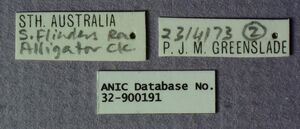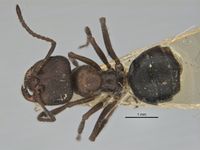Melophorus gibbosus
| Melophorus gibbosus | |
|---|---|

| |
| Scientific classification | |
| Kingdom: | Animalia |
| Phylum: | Arthropoda |
| Class: | Insecta |
| Order: | Hymenoptera |
| Family: | Formicidae |
| Subfamily: | Formicinae |
| Tribe: | Melophorini |
| Genus: | Melophorus |
| Species group: | aeneovirens |
| Species complex: | aeneovirens |
| Species: | M. gibbosus |
| Binomial name | |
| Melophorus gibbosus Heterick, Castalanelli & Shattuck, 2017 | |
Specimen data indicate it has been collected from Eucalyptus maculata open forest and from Callitris woodland as well as from a paddock. Queensland Museum material also confirms its presence in mulga and brigalow regrowth.
Identification
Heterick et al. (2017) - Melophorus gibbosus is a member of the Melophoprus aeneovirens species-group (in full-face view, the anterior clypeal margin convex, apron-like and covering whole or part of the retracted mandible, except in Melophorus nemophilus, the medial clypeal sector often produced so that it is protrusive when seen in profile; the psammophore frequently with coarse and well-separated ammochaetae, these always placed on or just above anterior margin; in profile, the propodeum elongate and oblique or broadly rounded), and the Melophoprus aeneovirens species-complex (in full-face view, psammophore ranged along or just above anterior margin of clypeus and following the curve of the margin; anterior margin of clypeus broadly medially produced, and often with central notch that may be deeply impressed, but is never acuminate at its midpoint; metatibia with maximum of two rows of preapical spines). In M. gibbosus the tibiae possess fine, appressed pubescence in addition to stout, socketed, appressed to subdecumbent setae. Unlike its near relative, Melophorus griseus, the frontal carinae of the worker are not raised or laminate at the edges; the frontal triangle is triangular in appearance and the sides of the head of minor worker are not divergent below eyes. In profile, the pronotum and mesonotum form a strong convexity, and this is very distinctive of the ant. The major worker also has a uniformly microreticulate head.
Based on its appearance, this species seems to be a member of a small clade that also includes Melophorus griseus and Melophorus canus. Erect bristly setae all over the head, body, antennal scapes and legs and a thoracic hump in the minor worker are sufficient to identify this species. The major worker has a distinctive, uniformly microreticulate frons.
Distribution
Melophorus gibbosus has a wide distribution in mainland Australia, but is relatively uncommon.
Distribution based on Regional Taxon Lists
Australasian Region: Australia (type locality).
Distribution based on AntMaps
Distribution based on AntWeb specimens
Check data from AntWeb
Countries Occupied
| Number of countries occupied by this species based on AntWiki Regional Taxon Lists. In general, fewer countries occupied indicates a narrower range, while more countries indicates a more widespread species. |

|
Estimated Abundance
| Relative abundance based on number of AntMaps records per species (this species within the purple bar). Fewer records (to the left) indicates a less abundant/encountered species while more records (to the right) indicates more abundant/encountered species. |

|
Biology
Castes
Worker
   
| |
| . | Owned by Australian National Insect Collection. |
Phylogeny
| Melophorus |
| ||||||||||||||||||||||||||||||||||||
Based on Heterick et al., 2017. Only selected species groups/complexes are included.
Nomenclature
The following information is derived from Barry Bolton's Online Catalogue of the Ants of the World.
- gibbosus. Melophorus gibbosus Heterick, Castalanelli & Shattuck, 2017: 102, fig. 13 (w.q.m.) AUSTRALIA.
Unless otherwise noted the text for the remainder of this section is reported from the publication that includes the original description.
Description
Worker
(n = 6): CI 95–107; E 18–27I; EL 0.21–0.27; HL 0.81–1.42; HW 0.77–1.52; ML 1.14–1.62; MTL 0.65–0.93; PpH 0.13–0.23; PpL 0.49–0.73; SI 77–121; SL 0.93–1.18.
Minor. Head. Head approximately oval with straight sides; posterior margin of head weakly convex; frons matt or with weak sheen, microreticulate or microreticulate-shagreenate; frons consisting of appressed pubescence, with many short, unmodified, erect setae. Eye moderate (eye length 0.20–0.49 length of side of head capsule); in full-face view, eyes set above midpoint of head capsule; in profile, eye set anteriad of midline of head capsule; eye more-or-less circular. In full-face view, frontal carinae concave; frontal lobes straight in front of antennal insertion. Anteromedial clypeal margin narrowly convex and protruding, clypeal midpoint distinctly notched; clypeal psammophore set at or just above anterior clypeal margin; palp formula 6,4. Five to six mandibular teeth in minor worker; mandibles triangular, weakly incurved; third mandibular tooth distinctly shorter than apical tooth and teeth numbers two and four; masticatory margin of mandibles approximately vertical or weakly oblique. Mesosoma. Integument of pronotum, mesonotum and mesopleuron moderately shining and shagreenate throughout; anterior mesosoma in profile pronotum smoothly rounded anteriad and flattened posteriad, mesonotum narrowly convex; appearance of erect pronotal setae short, (i.e., longest erect setae shorter than length of eye) and unmodified; in profile, metanotal groove shallow, broadly V or U-shaped; propodeum shining and shagreenate; propodeum always smoothly rounded; propodeal dorsum and declivity confluent; erect propodeal setae present and abundant (greater than 12); appressed propodeal setulae long and closely aligned, creating pubescence; propodeal spiracle situated at least twice its width from the declivitous face of propodeum, and shorter (length < 0.50 × height of propodeum). Petiole. In profile, petiolar node squamiform; in full-face view, shape of petiolar node uniformly rounded; node shining and distinctly shagreenate-microreticulate. Gaster. Gaster weakly shining with indistinct shagreenation; pilosity of first gastral tergite consisting of thick, appressed setae that form pubescence, interspersed with numerous short, bristly, erect setae. General characters. Colour concolorous brown.
Major. Head. Head oval; posterior margin of head planar or weakly convex; cuticle of frons matt or with weak sheen, microreticulate; frons consisting of appressed pubescence, with many short, unmodified, erect setae. Eye moderate (eye length 0.20–0.49 length of head capsule); in full-face view, eyes set above midpoint of head capsule; in profile, eye set anteriad of midline of head capsule; eyes elliptical. In full-face view, frontal carinae straight, divergent posteriad; frontal lobes straight in front of antennal insertion. Anterior clypeal margin narrowly convex and protruding anteromedially, clypeal midpoint notched; clypeal psammophore set at or just above anterior clypeal margin; palp formula 6,4. Five mandibular teeth in major worker; mandibles triangular, weakly incurved; third mandibular tooth distinctly shorter than apical tooth and teeth numbers two and four; masticatory margin of mandibles approximately aligned vertically or weakly oblique. Mesosoma. Integument of pronotum, mesonotum and mesopleuron matt with indistinct shagreenate sculpture throughout; anterior mesosoma in profile pronotum smoothly rounded anteriad and flattened posteriad, mesonotum narrowly convex; erect pronotal setae short, (i.e., shorter than length of eye) and unmodified; in profile, metanotal groove shallow, broadly V- or U-shaped; propodeum matt or with a weak sheen and indistinctly shagreenate; propodeum smoothly rounded or with indistinct angle; propodeal dorsum and declivity confluent; erect propodeal setae present and abundant (at least a dozen); appressed propodeal setae long and closely aligned, creating pubescence; propodeal spiracle situated nearer to midpoint of propodeum than to its declivitous face, and shorter (length less than 0.50 × height of propodeum). Petiole. In profile, petiolar node squamiform; in full-face view, shape of petiolar node generally rounded with median indentation; node shining and faintly shagreenate-microreticulate. Gaster. Gaster weakly shining with indistinct shagreenation; pilosity of first gastral tergite consisting of thick, appressed setae that form pubescence, interspersed with numerous short, bristly, erect setae. General characters. Colour brown, head and gaster darker than mesosoma.
Type Material
Holotype minor worker from Alligator Creek, S. Flinders Ra., South Australia, 23 April 1973, P.J.M. Greenslade [ANIC32-900191] Australian National Insect Collection. Paratypes: 2 major workers, 2 minor workers, 1 alate queen, 1 male from Watsonia, Victoria, 24 May Revision of the ant genus Melophorus (Hymenoptera, Formicidae) 103 1958, B. B. Lowery, ‘Melophorus biroi’ [sic] [ANIC32-900073] The Natural History Museum; 3 minor workers from CSIRO Lake Mere field stn near Louth, New South Wales, paddock B Grove, January 1995, M. Bryannah, ‘Meloph. sp. × 6’ Museum of Comparative Zoology; minor worker from Bauple, Queensland, August 1996, C. Vanderwoude, S.F. 958 E. maculata open forest plot 11 cpt 19, Melophorus sp. B Queensland Museum, 1 media worker from Fowlers Gap, New South Wales, November 1979, P.J.M. Greenslade, Traps 5 (27) Western Australian Museum.
Etymology
Late Latin gibbosus (‘humpbacked’); adjective in the nominative singular.
References
- Heterick, B.E. 2021. A guide to the ants of Western Australia. Part I: Systematics. Records of the Western Australian Museum, Supplement 86, 1-245 (doi:10.18195/issn.0313-122x.86.2021.001-245).
- Heterick, B.E. 2022. A guide to the ants of Western Australia. Part II: Distribution and biology. Records of the Western Australian Museum, supplement 86: 247-510 (doi:10.18195/issn.0313-122x.86.2022.247-510).
- Heterick, B.E., Castalanelli, M., Shattuck, S.O. 2017. Revision of the ant genus Melophorus (Hymenoptera, Formicidae). ZooKeys 700, 1–420 (doi: 10.3897/zookeys.700.11784).

